Over 100 years ago, the fields of Belgium witnessed events which changed the landscape of the world. The picturesque countryside of West Flanders in Belgium lies Ypres (or Ieper), where the horrors of World War 1 were fiercest. Some of the most monumental battles occurred in the region, and this guide will help you explore the history and important events. Today, Ypres is a tranquil and pretty city with a sombre yet enlightening reminder of the past, which leaves a lasting impression. This itinerary will take you to the most significant Ypres Battlefield sites over a 5-day historical trip.
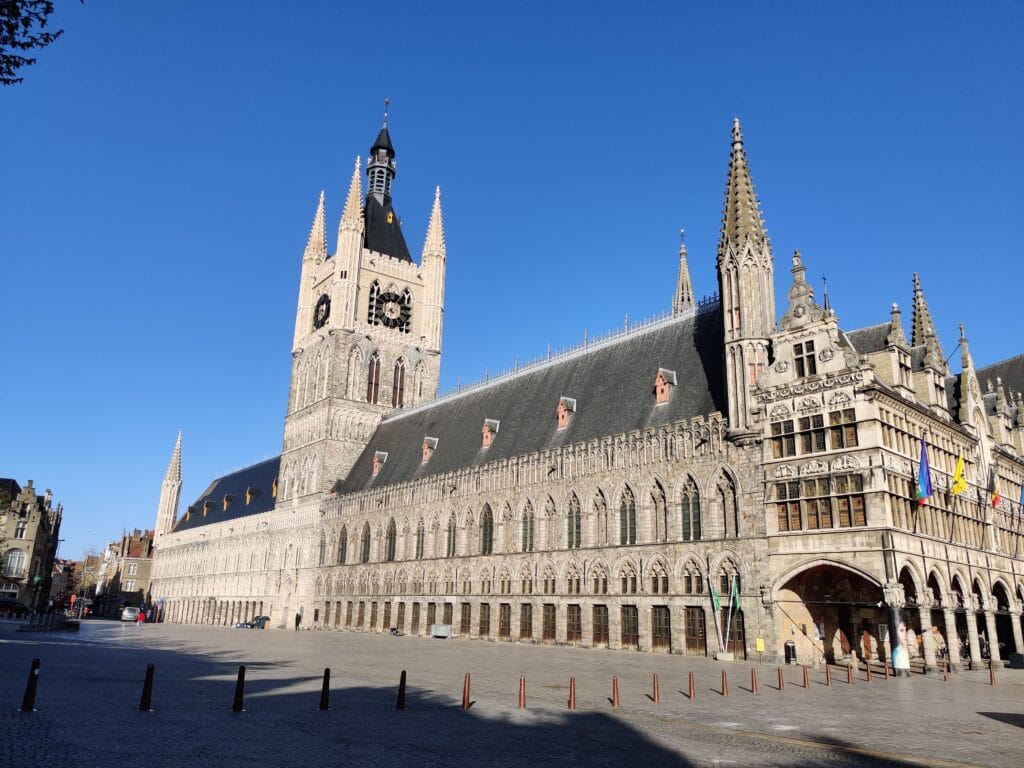
Ypres
For years, my Dad and I had been talking about touring the Ypres Battlefield sites from the Great War. In 2023, we booked a hotel and train for a 5-day Easter trip with Ypres as our basecamp to explore from. The Itinerary was packed with a day dedicated to watching the famous Paris-Roubaix cycle race and many spontaneous stops. Ypres (or Ieper in Dutch) has a wide range of hotels and restaurants to accommodate tourists. It is a charming city that has a fascinating history intertwined with War and older history as well. Whilst Guided Tours with History experts will allow you to gain a greater knowledge of specific events. We found that each Ypres Battlefield site, memorial or cemetery had information boards in different languages to read and learn from.
This Ypres battlefield tour allows you to remember and honour those who served and sacrificed. It’s best not to rush the itinerary and take time to reflect on the magnitude of what happened in Flanders. A car will give the most flexibility to adapt your itinerary and freely drive around the towns, villages and sites. And there is a good amount of walking so don’t forget to pack your walking shoes as you embark on journey through time.
Ypres Must-Visit Sites
- Menin Gate Memorial: This iconic monument is dedicated to the missing soldiers of the Commonwealth forces who have no known grave. Every evening, the Last Post ceremony is held here, a moving tribute that echoes the memory of those who gave their lives.
- In Flanders Fields Museum: Housed in the Cloth Hall, this museum offers an immersive experience, with interactive exhibits and personal stories that bring the events of the Great War to life.
- Tyne Cot Cemetery: The largest Commonwealth War Graves Commission cemetery in the world, Tyne Cot is the final resting place for over 11,000 soldiers. The sheer number of headstones is a stark reminder of the war’s devastating toll.
- Hill 60: This strategic vantage point was the site of intense underground warfare. Today, you can explore the preserved craters and trenches that tell the story of the battle fought above and below ground.
- Sanctuary Wood Museum and Trenches: Experience the claustrophobic conditions of the trenches first-hand. The museum here offers a vast collection of artifacts, including weapons, uniforms, and photographs.
Ypres endured five major battles during World War I, with the First Battle of Ypres marking the beginning of the long and gruelling Western Front. The city’s strategic location made it a focal point for the Allies and the Central Powers, resulting in relentless fighting. As you explore the Ypres battlefield sites, you’ll encounter places that saw bravery, sacrifice, and resilience of soldiers who fought over a century ago.
Ypres Battlefield Itinerary
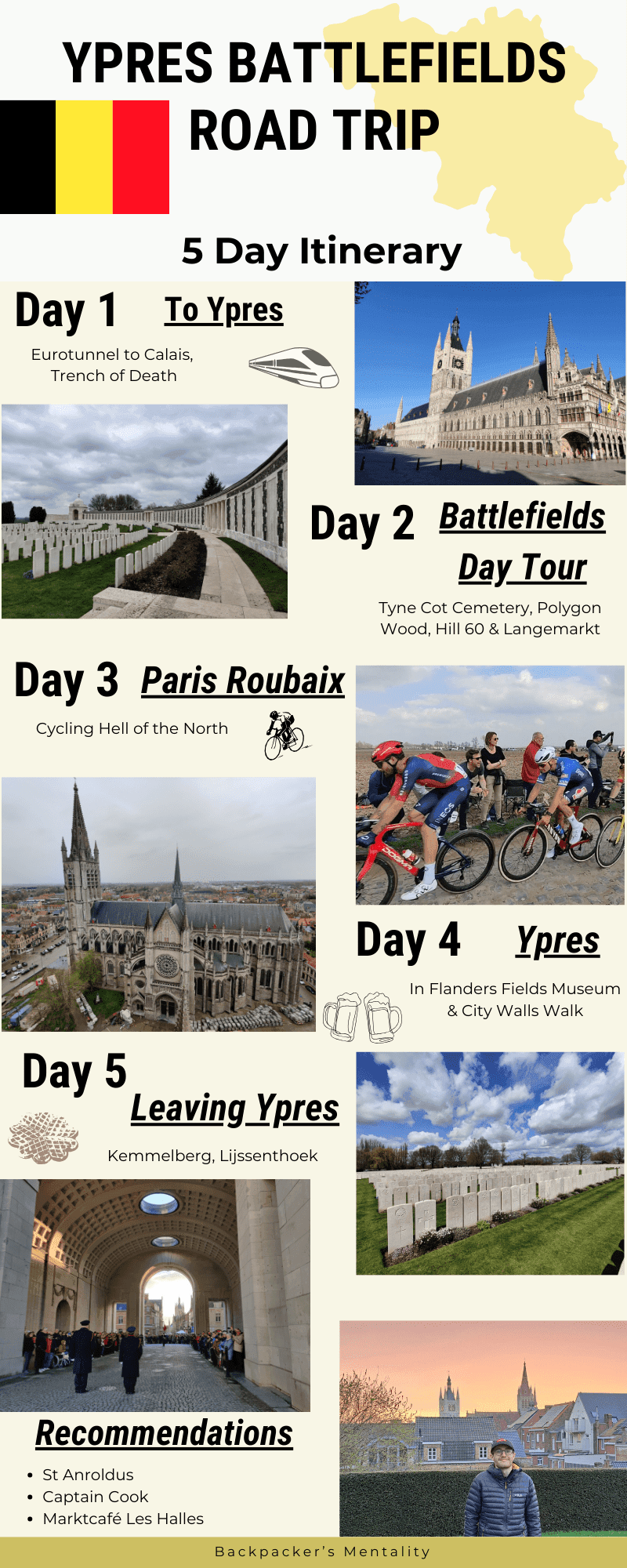
Ieper Site Map
Day 1 – To Ypres
To maximise the trip, it’s an early start with a drive from London down to Folkestone to catch the EuroTunnel. My Dad and I would share driving my Seat Leon with most sites a short drive from each other. After a short pitstop, we boarded the train and were in Calais by 9:40 with my Dad driving us through Northern France into Belgium.
Dodengang (the Trench of Death)
The first stop of the Ypres battlefield trip was to Dodengang, with the gruesome name “The Trench of Death”. This site is located near Diksmude, around a 30 minute drive from Ypres. If you want to immerse yourself in trench warfare, then Dodengang has maintained trenches banking the Yser river. The history of this famous battle between Belgian and German soldiers over the banks is detailed in the visitors’ centre. Despite being the first visit, Dodengang was one of my favourites for how real the experience felt.
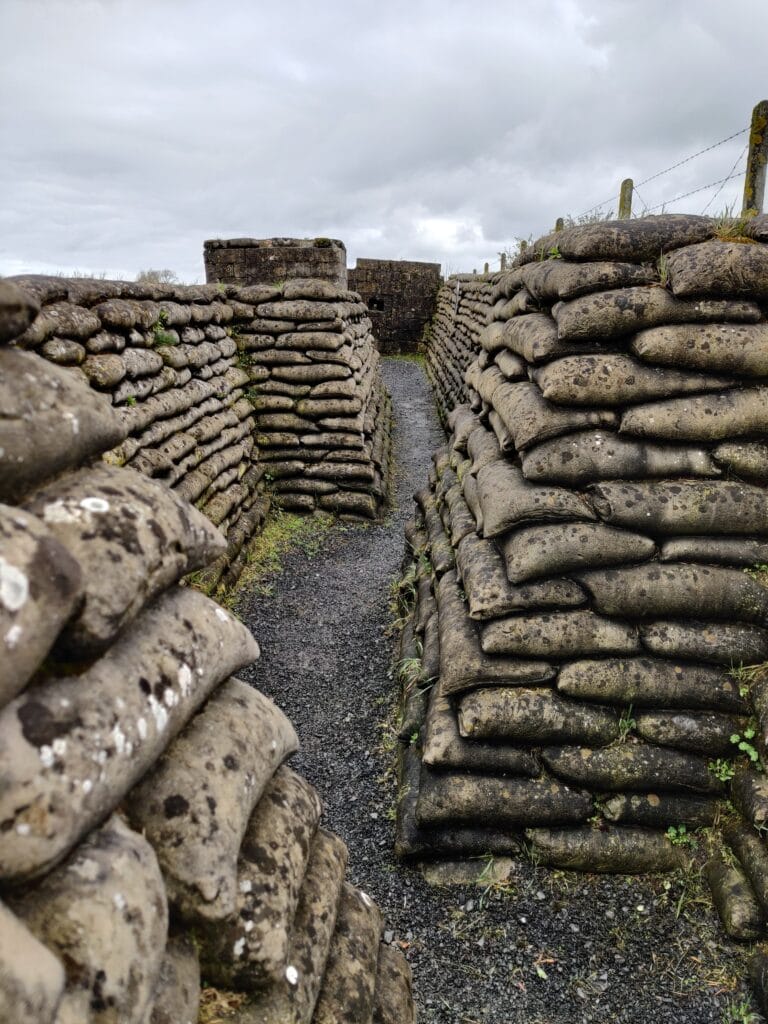
Vladslo German War Cemetery
The next stop before arriving in Ypres was Vladslo, to the north of Ypres. It was the first cemetery we visited and it was impactful to see the different style of German gravestones. Vladslo was quieter than other cemeteries however, the scale is misleading. There are 25,644 buried here after the war, with each stone having 20 names engraved upon it.
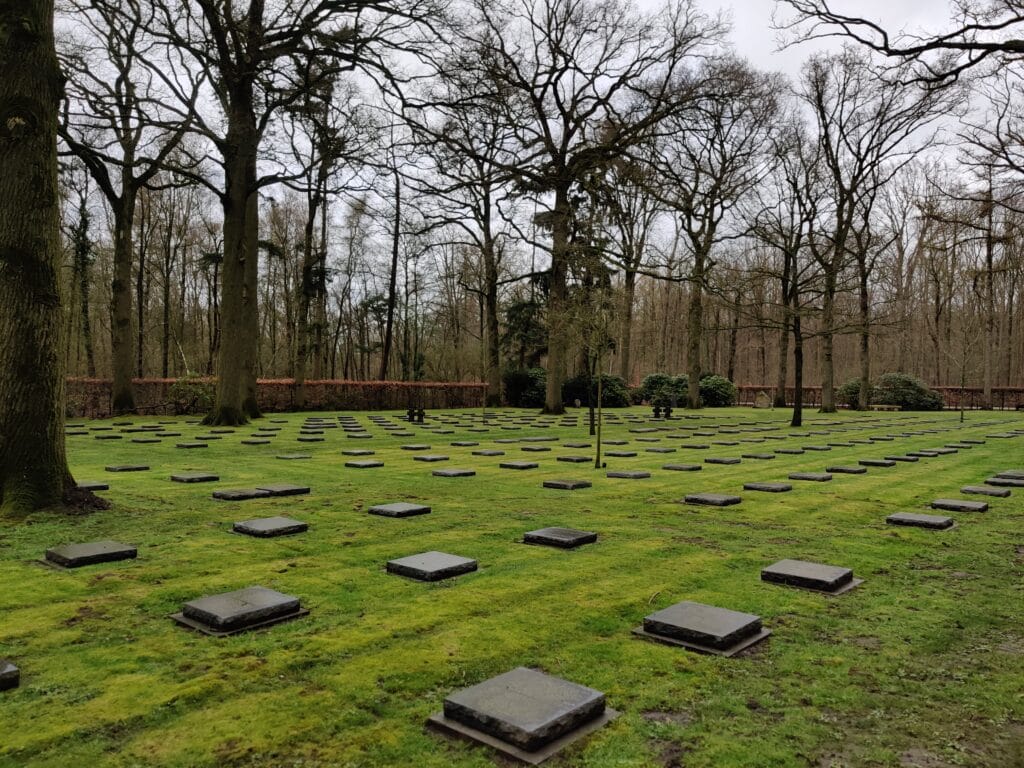
Before we parked up to check into the hotel, we visited a few cemeteries on the road into Ypres. My Dad is a Commonwealth War Graves Commission volunteer, so there were many places to see based on his research. We visited Essex Farm Cemetery and John MaCrae Memorial, where the poet famously wrote In Flanders Fields. After a careful drive through Ypres, we parked up at Parkenplaats and walked over the river into the walled town.
Ypres & Menin Gate Ceremony
We checked into the Novotel hotel located in the centre of town and had an afternoon to roam around Ypres. The first priority was to get some lunch, where we chose Ypresbruger for some fast food burgers, chips and beer! Afterwards, we walked around the town hall square and over to Menenpoort (Menin Gate). This stunning Arc has the names of the fallen soldiers during World War 1 in the Ypres Salient. We toured around the shops and scouted out restaurants before heading back to Menin Gate. The Last Post ceremony at daily at 8pm is worth waiting for the memorial service.
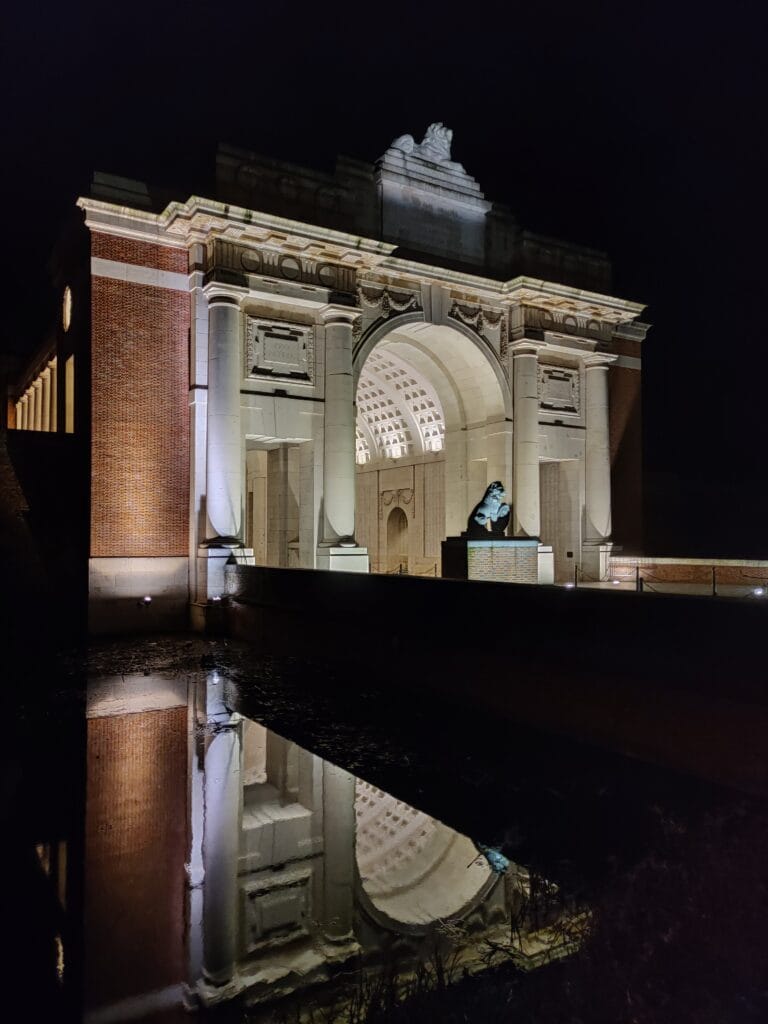
Dinner was much needed and we luckily got a table at Captain Cook. This Italian served tasty Pizza and I found my new favourite beer, St Bernardus (also very strong!). To our surprise, as we walked past the Cloth Hall, a crowd had gathered as we heard drumming. A giant Roman-style mechanical soldier was “walking” before an impressive fireworks display in front of the Cloth Hall.
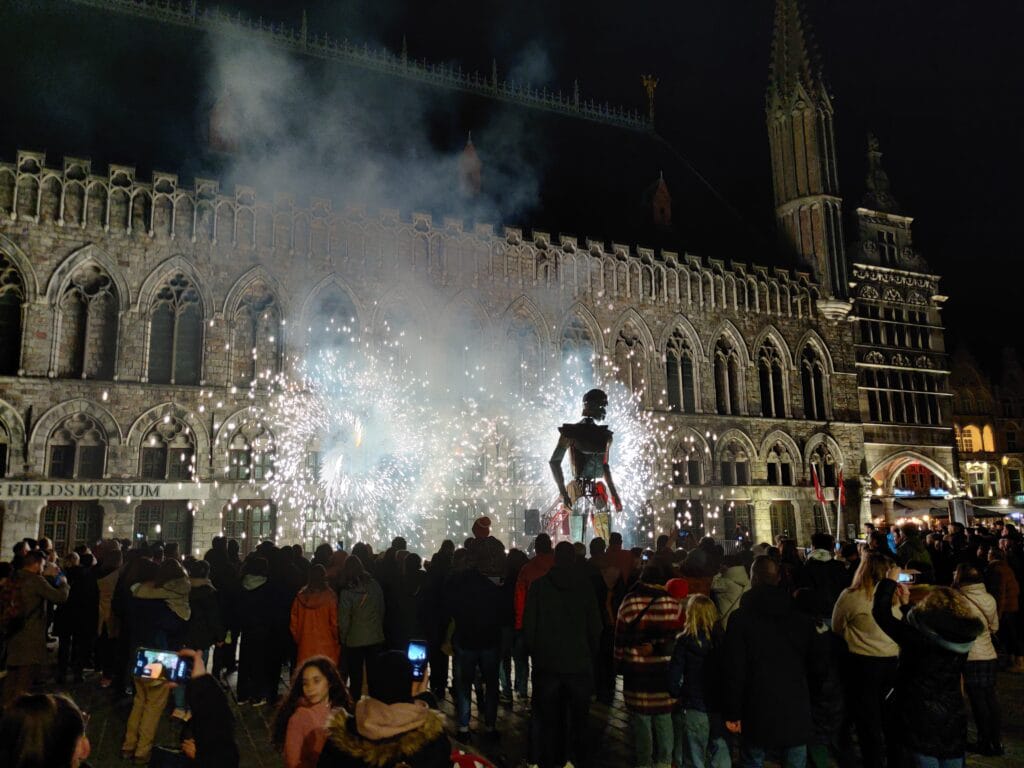
Day 2 – Battlefields Day Tour
Day 2 started with a stroll around the Saturday market, seeing all the flowers, plants, food and items for sale. If you’re staying over the weekend, then don’t lie in and miss the buzzing marketplace outside the Cloth Hall (Lakenhallen). There are plenty of cafes and places to grab breakfast before heading out for the day. Even though we picked up food from supermarkets, places that caught my attention were Milk ‘n Sugar and Kaffee André.
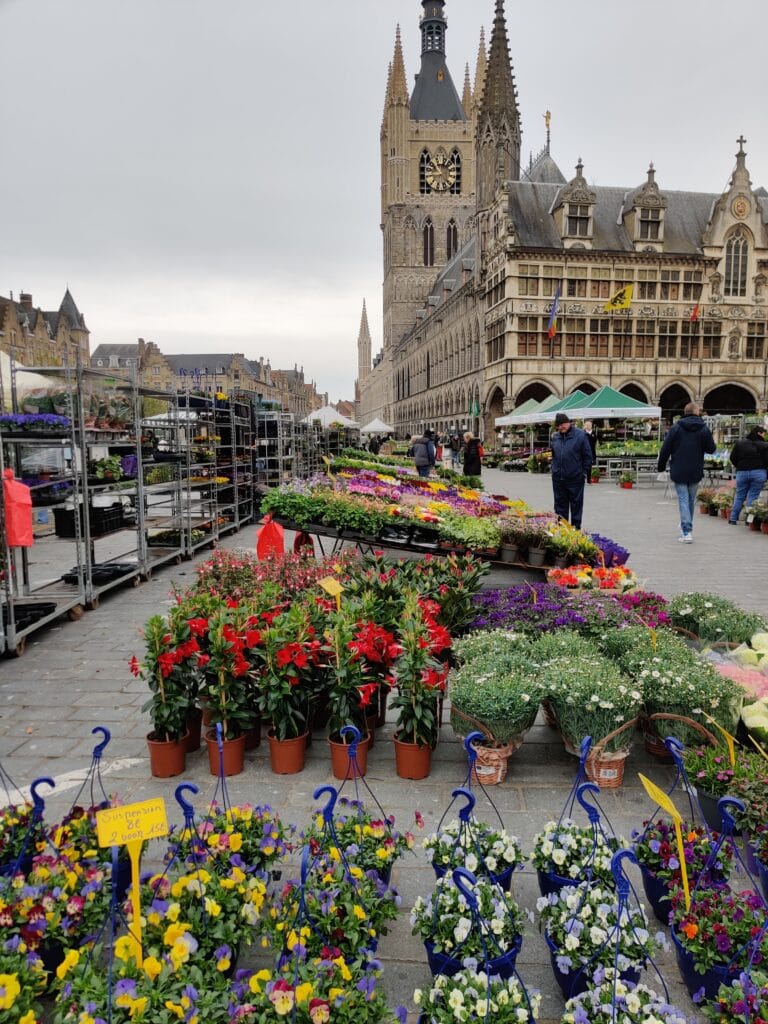
Polygon Wood
The first stop of the Ypres Battlefield Tour was to Polygon Wood, Zonnebeke, around a 15 min drive from Ypres. This site is known for the Battle of Polygon Wood in the Third Battle of Ypres. With multiple cemeteries, memorial sites and bunkers scattered throughout the woods, it is easy to spend an hour walking around. At one corner is Black Watch Corner and another corner has the moving Brothers In Arms Memorial Park. A fitting tribute to the story of brothers, Jim and John Hunter, from the Australian regiment.
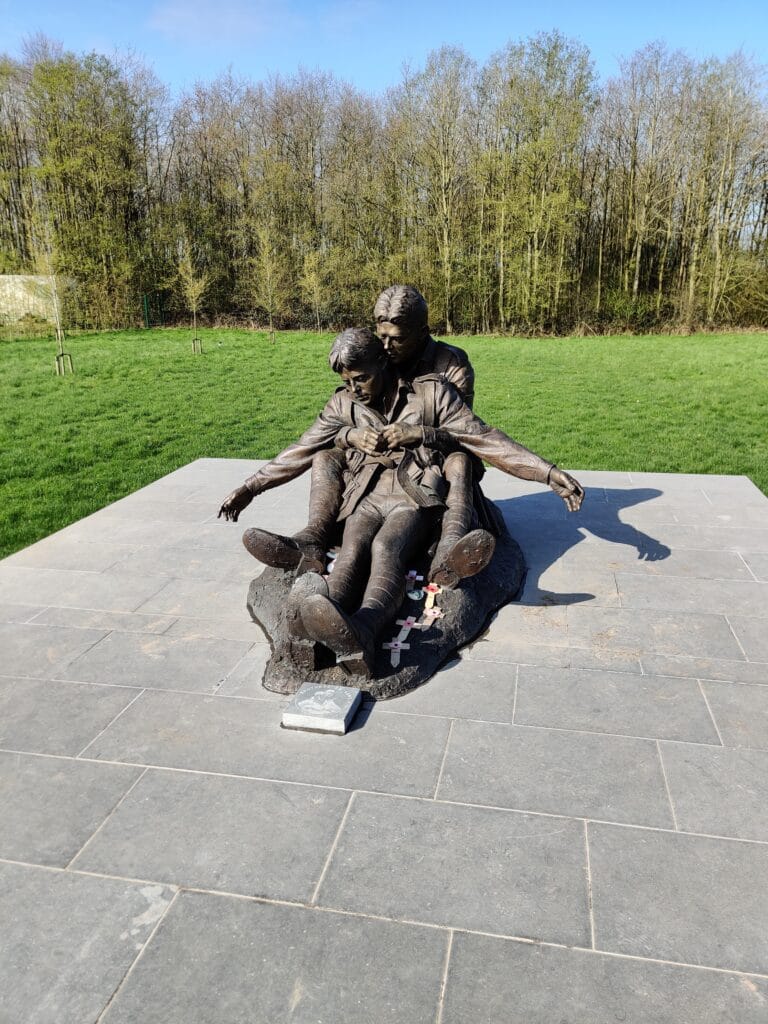
Tyne Cot Cemetery
Tyne Cot is one of the must-see Ypres Battlefield cemeteries! It is the largest Commonwealth cemetery in the world, and the scale takes some comprehending. The names of the buried are engraved on the plaques in a semicircle around the tombstones. And it is worth taking your time in the visitor centre before walking around to pay your respects. The battle of Passchendaele is one of the most well-known battles in the war, which was fought close by. There are 11,965 servicemen commemorated at Tyne Cot Cemetery.
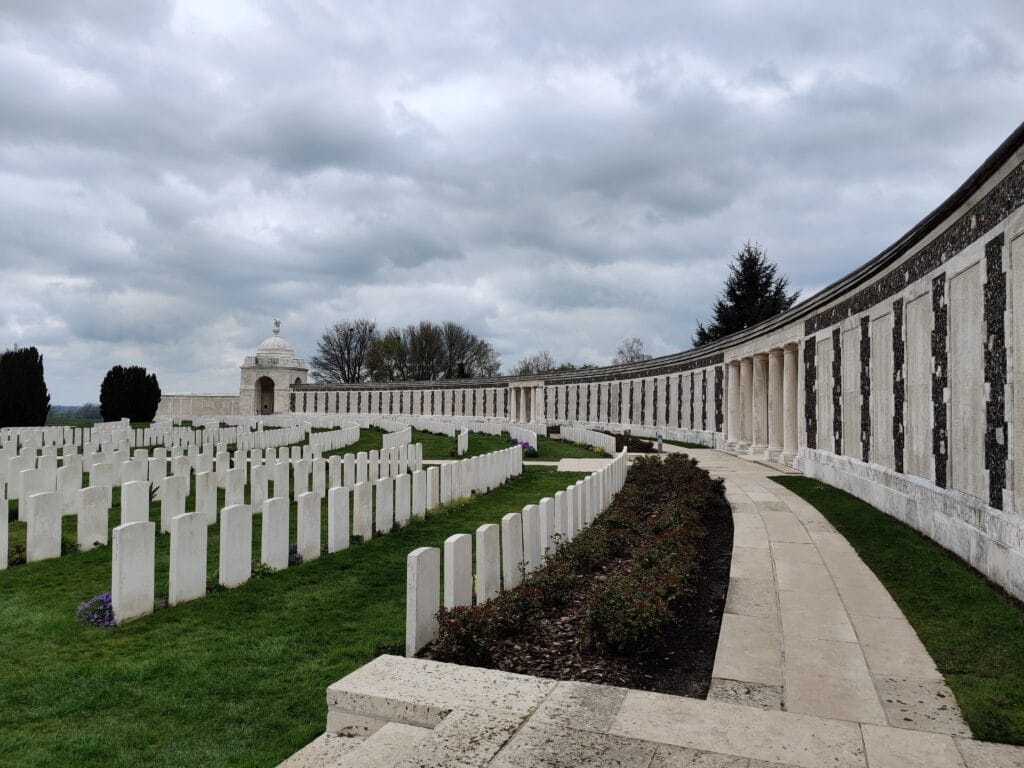
Langemark German Cemetery
From Tyne Cot, the next stop of the tour was a 15-minute drive towards Langemark-Poelkapelle. The Saint Julien Memorial (The Brooding Soldier) is an imposing statue dedicated to the Canadian First Division in the village. A short drive later will take you to Langemark German Cemetery, where over 44000 German soldiers are buried. The first recorded poison gas attack occurred in Langemark, which marked the start of the Second Battle of Ypres. Upon reflection, this horrific attack was a pivotal point in military history.
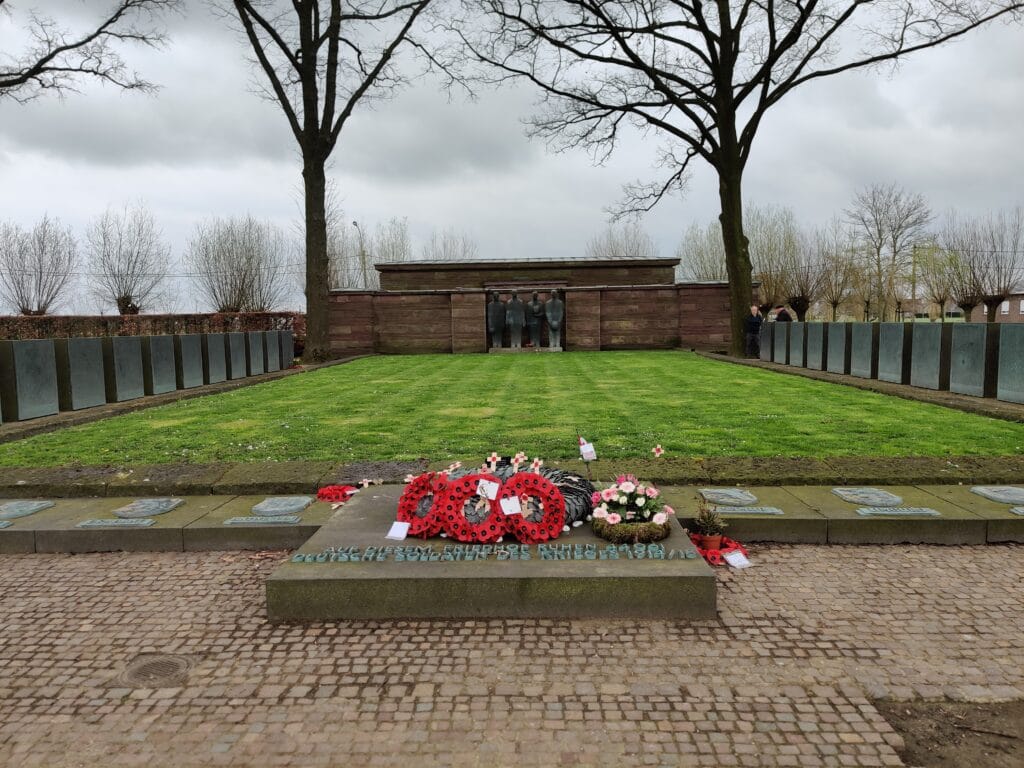
Hill 60
After lunch, we drove to Hill 60, a short distance away. This was of tactical advantage due to its prominence and faced fierce battles to capture it. The car park is very small as coaches and minibuses also visit this popular spot. There are nice walks around Hill 60 to see the remaining scars from the conflict in the landscape. There are craters, ruined bunkers, and memorials to be observed around Hill 60.
Hill 62 & Sanctuary Wood Cemetery
The last stop on Day 2’s Ypres Battlefield Tour was to Hill 60 & Sanctuary Wood near Hooger Crater. This is a memorial and cemetery to the Canadian divisions fighting in the area, and has a lot to see. First, start with the memorial on the hill with views of the Flanders fields in the distance. Then walk back down to the Museum, which has replica Trenches and bunkers to get a first-hand experience. Sanctuary Wood cemetery is 100m down the road, where semi-circular rows of grave stones and 60% are unknown. Back along the road is Hooger Crater Cemetery and Museum (€ 9) next to Bellewaerde Aquapark. The cemetery is next to the fast road to Ypres, with no actual car park.
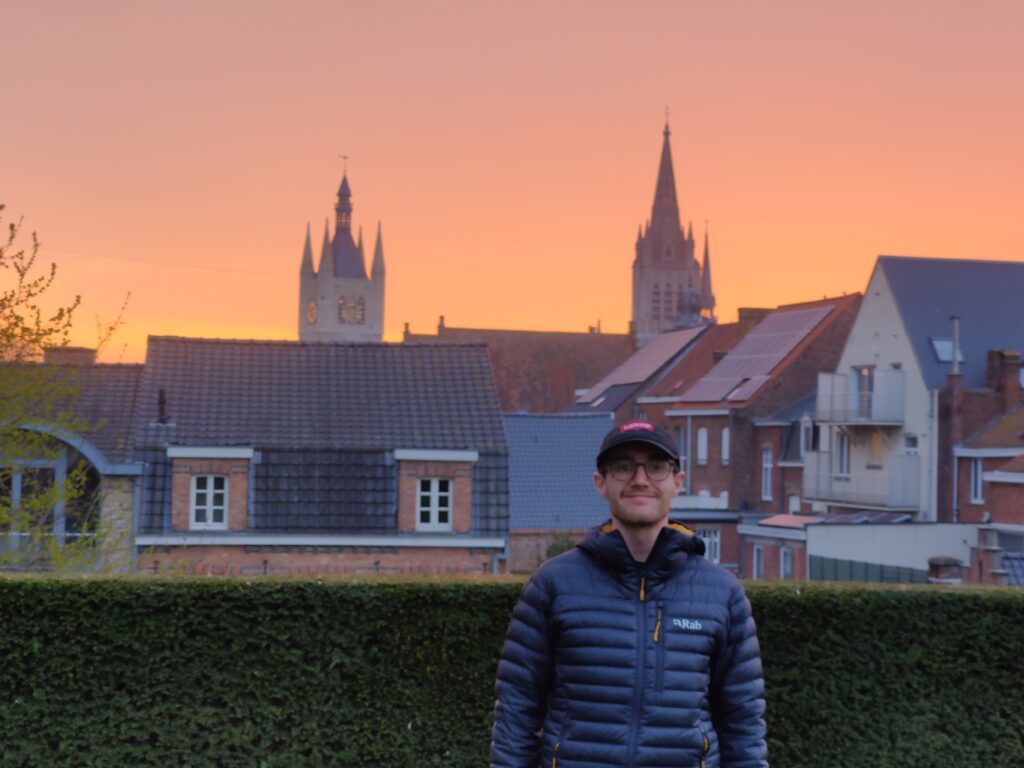
Ypres Evening
After a full day out driving around the Battlefield sites, we returned back to Ypres for a quick rest. It was time to sample some lovely Belgian beer at St Arnoldus beer café. We sat in the beer garden tasting St.Bernadus Tripel, St.Bernadus Wit, Rodenbach and a Trappist beer. These were stronger than expected but very tasty, especially in the beer garden. We attended the La Post Ceremony at Menin Gate before enjoying a beautiful orange sunset over the town skyline. For dinner, we got a table at Depot, where I enjoyed a Falafel curry and my Dad had a fish main. Then we indulged in a delicious meringue tart for dessert before retreating to the hotel after a long day.
Day 3 – Paris Roubaix
Before the day trip to France, we took a misty walk to stretch our legs around the deserted town. Then a quick breakfast in the hotel and packed the packs for the day. Finally, we picked up food from a supermarket as we would be waiting hours next to a cobbled road.
Paris-Roubaix Cycling
Paris-Roubaix is a one-day Cycling Classic in northern France that is famous for its brutal racing on the cobbled sectors. With over 29 cobbled sectors totalling over 54km, this 250km race is one of the most brutal and tough. Each cobbled sector is graded with 5* being the hardest, so we scouted out where to watch the thrilling racing. The hardest sector is Trouée d’Arenberg, with the arrow straight cobbles through the forest,. It is always packed with supporters and has huge cobbles protruding out of the surface for riders to skilfully avoid. Carrefour de l’Arbre sector is a decisive sector with its proximity to Roubaix. However, we chose to watch the race at Camphin-en-Pévèle (Sector 5). Now, the Eddy Merckx Sector, this 4* and 1.8km sector was through exposed fields and only 20K to the finish.
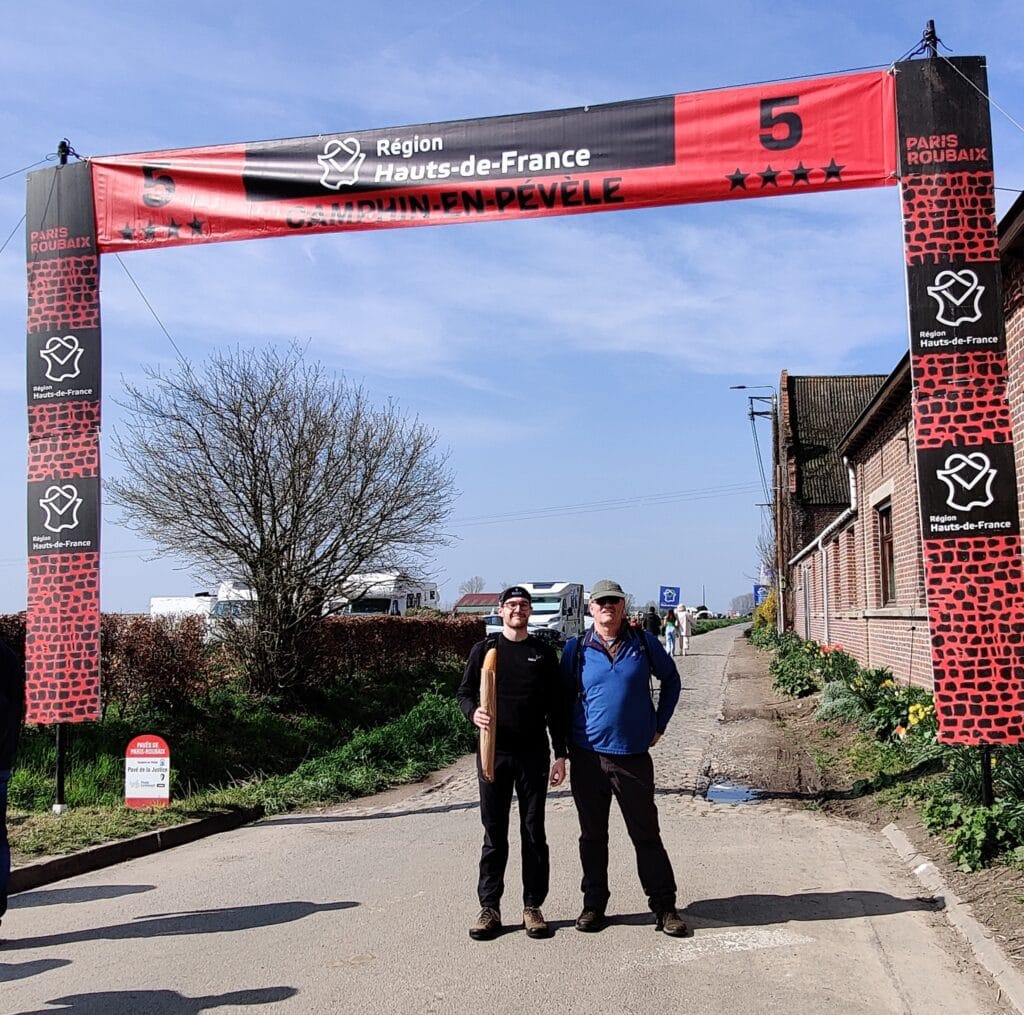
The atmosphere was incredible, with thousands camping overnight to start the party in the morning. We arrived after lunch and waited 3 hours for the race, so we soaked up the sun and atmosphere. If you’re a cycling fan, then this is a must-watch race and make plans in advance. We parked near Bourghelles and walked along the cobbled sector to get a good spot. It’s best to arrive in the morning to get a parking spot and save walking miles more than needed. Before the peloton passes through, police, sponsors and team cars will drive past, which builds the anticipation. The racing flew past us and kicked up a lot of dust! In the end, Mathieu Van Der Poel managed to distance Wout Van Aert at the next sector to win!
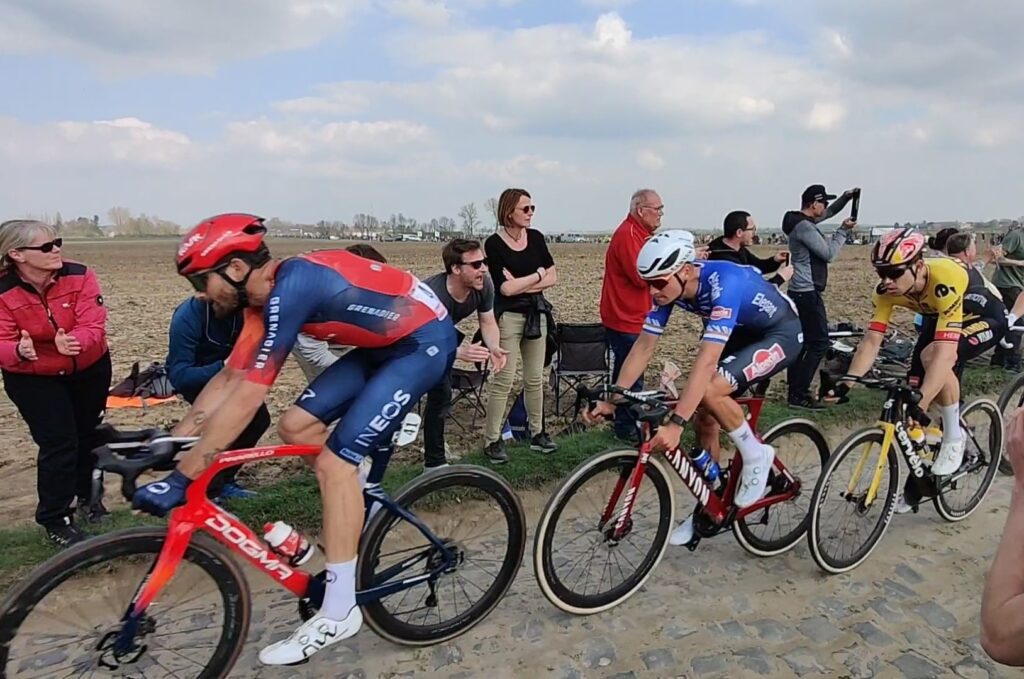
Evening
We returned to Ypres after the excitement of Paris-Roubaix in the late afternoon. Instead of beers, we decided to treat ourselves to some Belgian waffles from Il Gusto d’Italia on the square and enjoyed watching the Roman Soldier parade with fireworks outside the Cloth Hall. It was less dramatic than the first night because of the daylight, but it was still a fun spectacle. For dinner, we went to Market les Halles, where we luckily got a table and enjoyed a delicious Lasagne with Bockor Beer for myself and a stacked Burger for my Dad. I would highly recommend Market Les Halles, even if you have to wait!
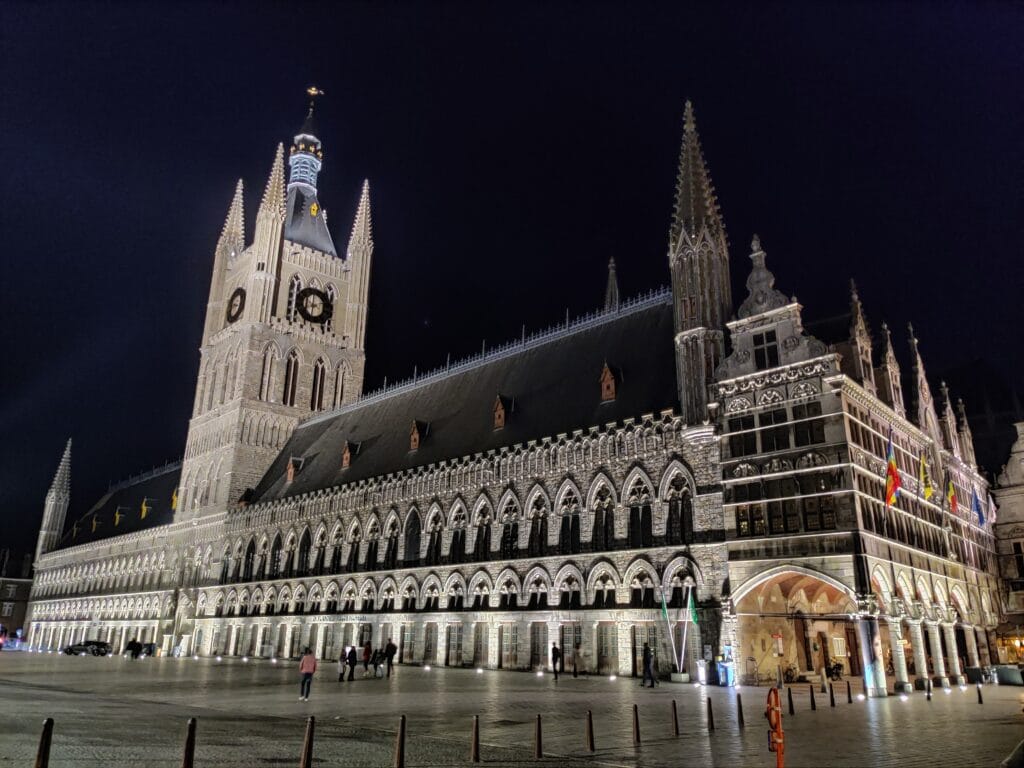
Day 4 – Ypres
Kemmelberg
The weather on Day 4 was mixed, with rain forecasted in the afternoon, which changed our plans. In the morning, we planned to explore the western battlefield sites and cemeteries. As a big cycling fan, I was keen to visit the Kemmelberg cobbled climb. This challenging road is part of the Gent–Wevelgem Flanders Classic race and is famous for the attacks up the steep 22% gradient hill! Kemmelberg was also a strategic point in World War 1 and witnessed tough battles to gain the advantage. Beforehand, the Kemmel Chateau Military Cemetery in Heuvelland is worth a short visit, and the town has plenty of cafes and shops to explore. This area is popular with locals for walks in nature, so parking can be a little busy. Additionally, Command Bunker Kemmel is located at the bottom of the Kemmelberg, where the secrets of the Cold War can be uncovered.
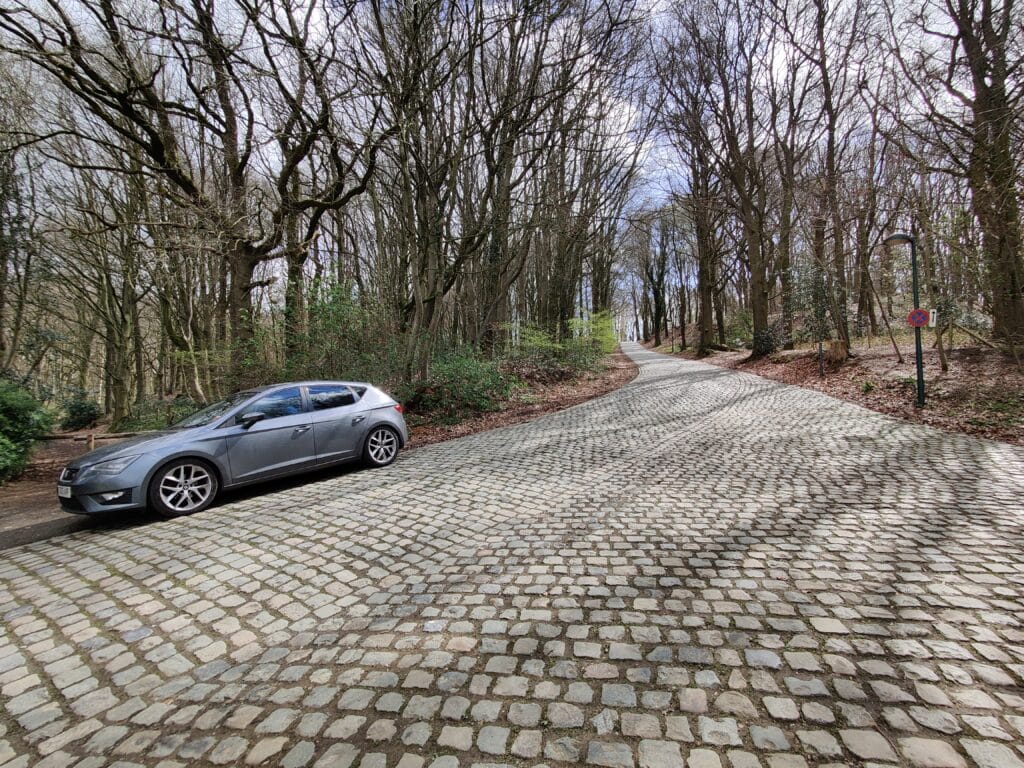
Battlefield Cemeteries
After driving up and down the Kemmelberg multiple times, attempting not to stall, we drove on to find several cemeteries along the country lanes. First, we visited Dickebusch New Military Cemetery, which was a small graveyard behind residential houses and had around 600 gravestones. And then I drove onto Grootebeek British Cemetery, an even smaller cemetery, located next to farms. Grootebeek was one of the most serene places with the stream, benches and trees, which made it a peaceful place to pay respects. Finally, we visited Brandhoek New Military Cemetery to see a rare sight – the grave of Captain Noel Godfrey Chavasse. He is one of only 3 servicemen in history to be awarded a double Victoria Cross for their heroic actions. Captain Chavasse was a medical doctor who rescued soldiers in no-man’s land while injured and under enemy fire.
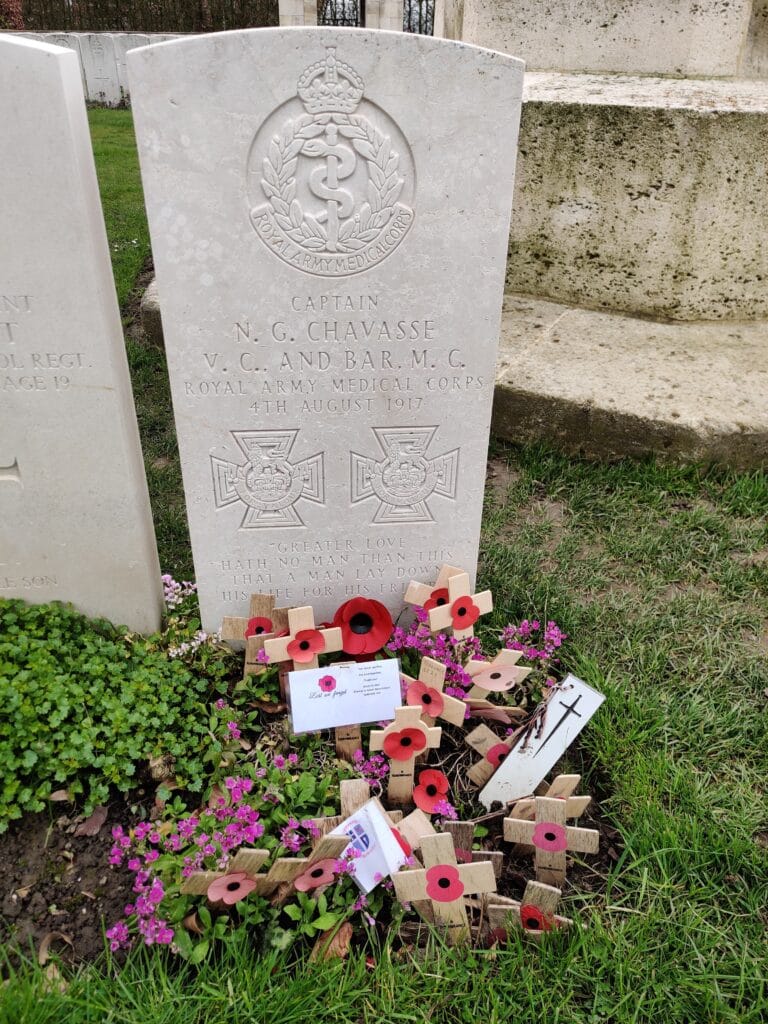
In Flanders Fields Museum
In the afternoon, we returned to Ypres with the plan to visit the In Flander’s Fields Museum situated within the Cloth Hall. The entry ticket for the In Flanders’ Fields Museum (IFFM) and Ypres Museum costs around €15.50 (£13) for an adult. Additionally, to climb up to the Belfry Tower for stunning views across Ypres only costs €2, which is absolutely worth it! First, you’ll learn about the origins of Ypres in the context of Flanders, Wallonia and Belgium and discover the riches gained from the Cloth Hall, which made Ypres a prosperous trading hub during the Middle Ages. The main exhibition is about World War 1 (the Great War) and the timeline of events that occurred between 1914 and 1918. There is a collection of artefacts, artwork and personal stories from soldiers and residents of Ypres during the conflict.
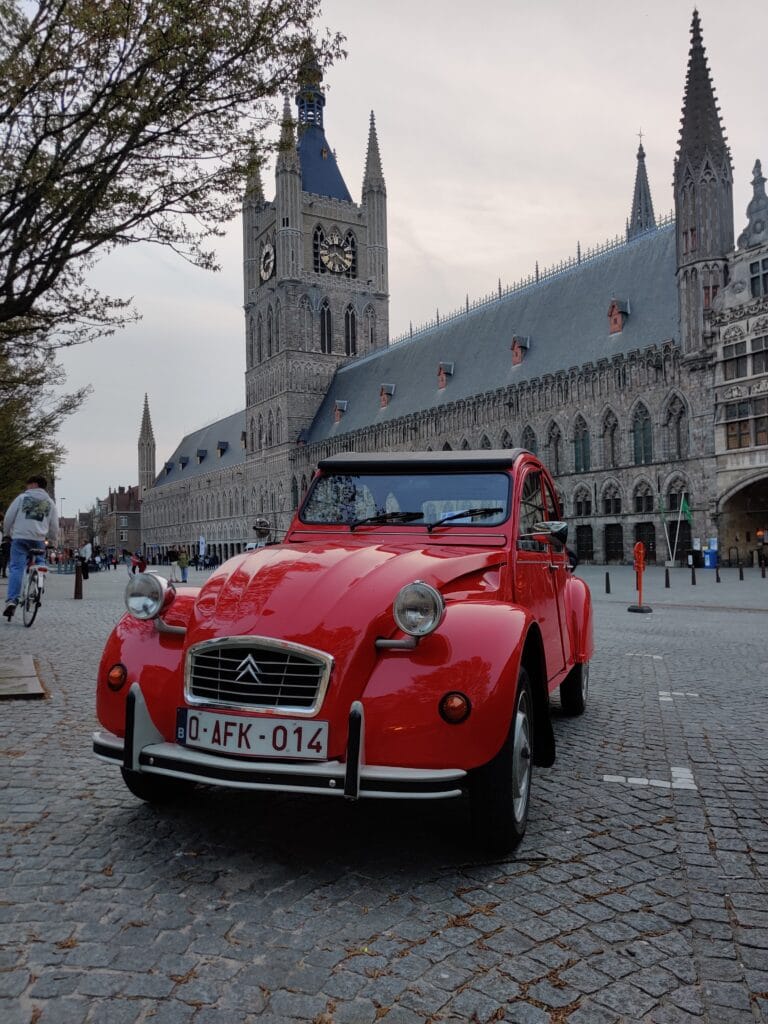
Belfry Tower Climb
There are immersive trenches and virtual graphics to show the changes in the landscapes caused by the Battles of Ypres. The objects found in the Flanders’ Fields, such as weapons, clothing and personal items, act as a strong remembrance to the 600,000 soldiers who died. It’s best not to rush through the museum as there are so many information panels and videos to watch and learn about the impact the war had on those fighting and on Ypres. After the museum, it’s time to climb the 231 steps up to the Belfry Tower. Even on a grey, rainy day, you can see the surrounding countryside and imagine the battles that occurred a century earlier. The best views are of St. Martin’s Cathedral to the north and of Menin Gate. Before descending, you can see the bells in the Belfry, and if you time it badly, you’ll hear the bells up close!
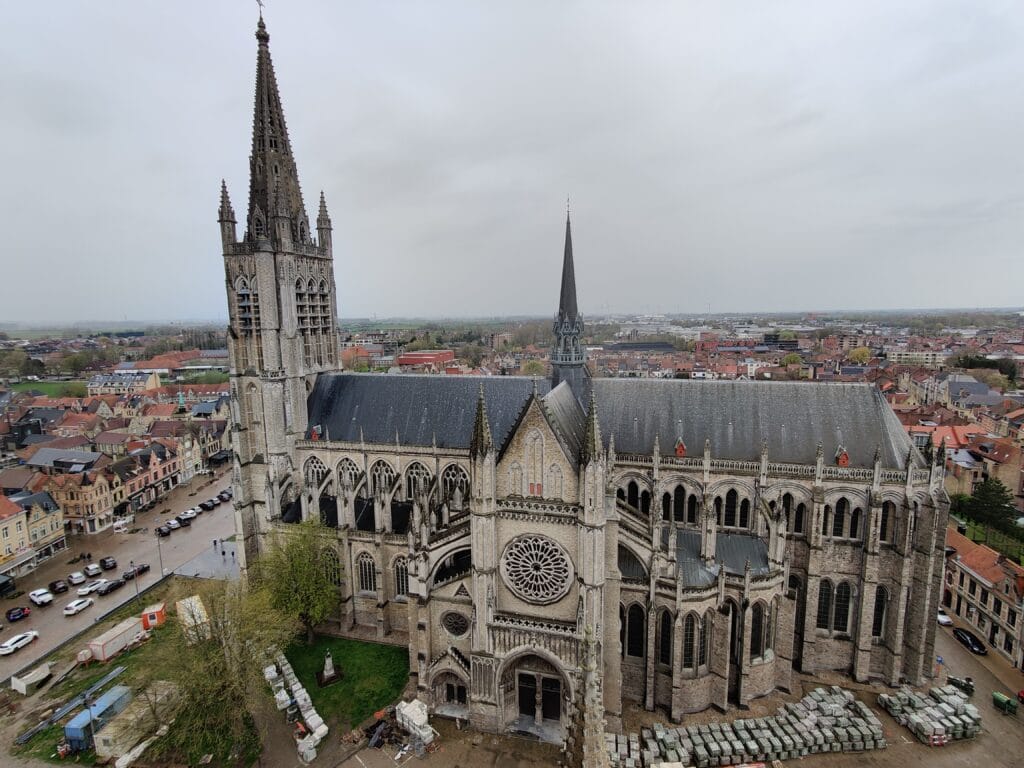
Ypres City Walls
In Ypres, we visited the Town Reservoir Cemetery (a Commonwealth War Graves Commission Cemetery) as my Dad was keen to see it. It is humbling to see such a large cemetery in the town surrounded by buildings compared to the other Battlefield cemeteries visited on this itinerary. St George’s Memorial Church was built to commemorate the 500,000 British and Commonwealth soldiers who died in the Ypres Salient and has plaques inside dedicated to individuals, organisations or regiments. After the church visit, we walked over to Ieper War Cemetery next to the waterfront and then walked along the city’s walls from Rijselpoort (Lille Gate) over to Menin Gate and beyond.
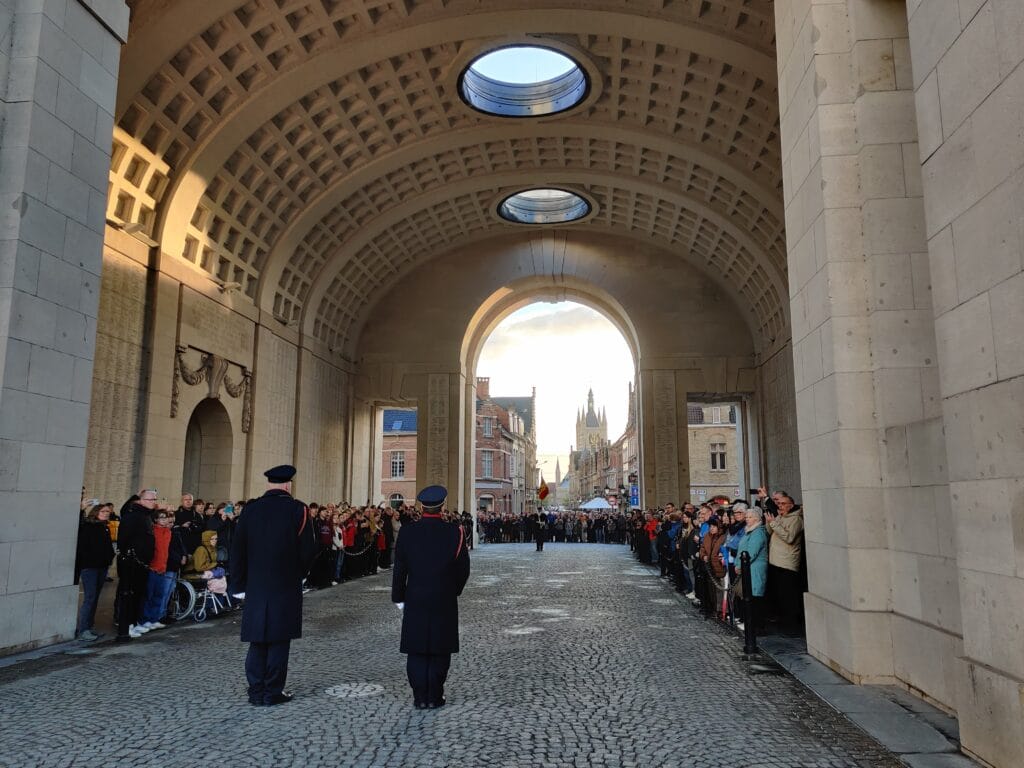
As a reward, we had some more Belgian Waffles to keep us fuelled before relaxing in the Hotel for a while. We went out for some beers at St Arnoldus again before attending the Menin Gate ceremony at 8pm. Each day, we attended the Last Post Service and had a different spot for the readings and trumpet performance. For the last dinner in Ypres, we decided to return to Market Les Halles where we had another delicious meal. For myself, a healthy salad bowl with crispy veggie bites, chips and a St Omer beer, whereas my Dad had the meat version of the Lasagna. We had desserts before a nice evening stroll, before retreating for a last night’s sleep.
Day 5 – Leaving Ypres
To start Day 5, we packed up our bags and dropped them off at the car in preparation for checking out. We took a lovely walk around the outside of the Moat water, which allowed us to observe the stone walls and blue sky. The walk was early in the morning wth quiet roads and allowed me to snap some good photos of the Cloth Hall and of Ypres. We had a quick breakfast at the hotel before checking out and then hitting the road to head towards Calais to get the EuroTunnel. There is a Spar Supermarket close by where we bought lunch and stocked up on Belgian Beer, 30 bottles and 4 gift beer glasses.
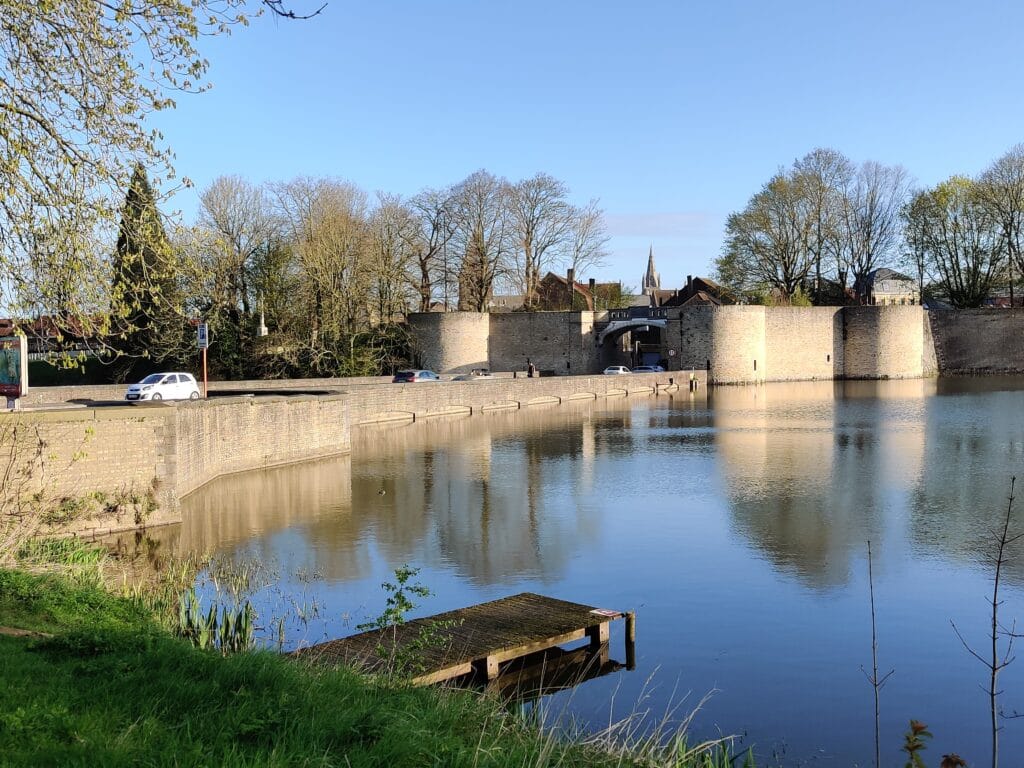
Christmas Truce Memorial
First stop was the Island of Ireland, Park of Peace, which has a stone tower constructed as a memorial for the Irish soldiers lost or missing in World War 1. Then, we drove over to the Christmas Truce Memorial, where the famous Christmas Day Football match between German and Allied troops took place. A temporary and unofficial truce occurred in December 1914, where troops went into No-Man’s Land to exchange gifts and talk. There is a cross, which is supposedly where the game took place and a more modern memorial near some bunkers. Not far from here are Mud Corner Cemetery, Toronto Avenue Cemetery, Ploegsteert Wood Military Cemetery and Rifle House Cemetery, all a short walk into the woods and very peaceful to attend. The Ploegsteert Memorial to the Missing is an impressive memorial close by to see as well when in the area.
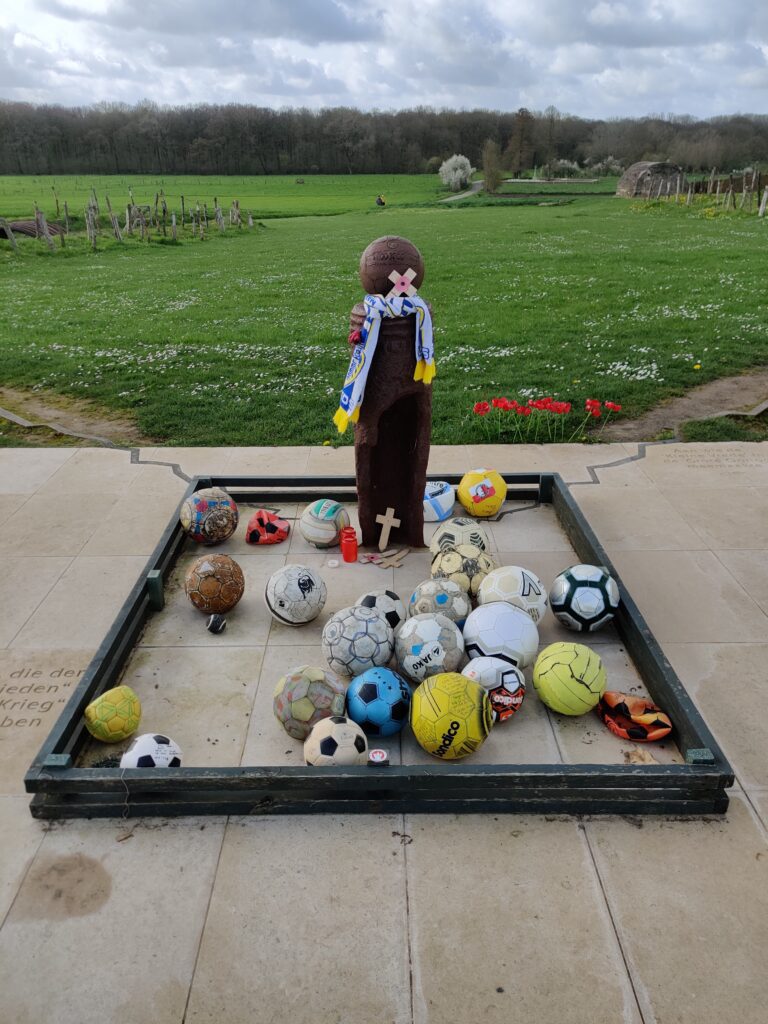
Visitor Centre Lijssenthoek Military Cemetery
The last and one of the most impactful Ypres Battlefield Tour sites is Lijssenthoek Cemetery. This cemetery is 12km from Ypres and has a very informative visitors’ centre about the airfield and military hospital. There are stories about how the injured were treated and, as expected, a vast cemetery due to those who did not recover from the injuries. This was the last cemetery we visited and one of the hardest due to the sheer scale of the 11,000 grave stones at Lijssenthoek.
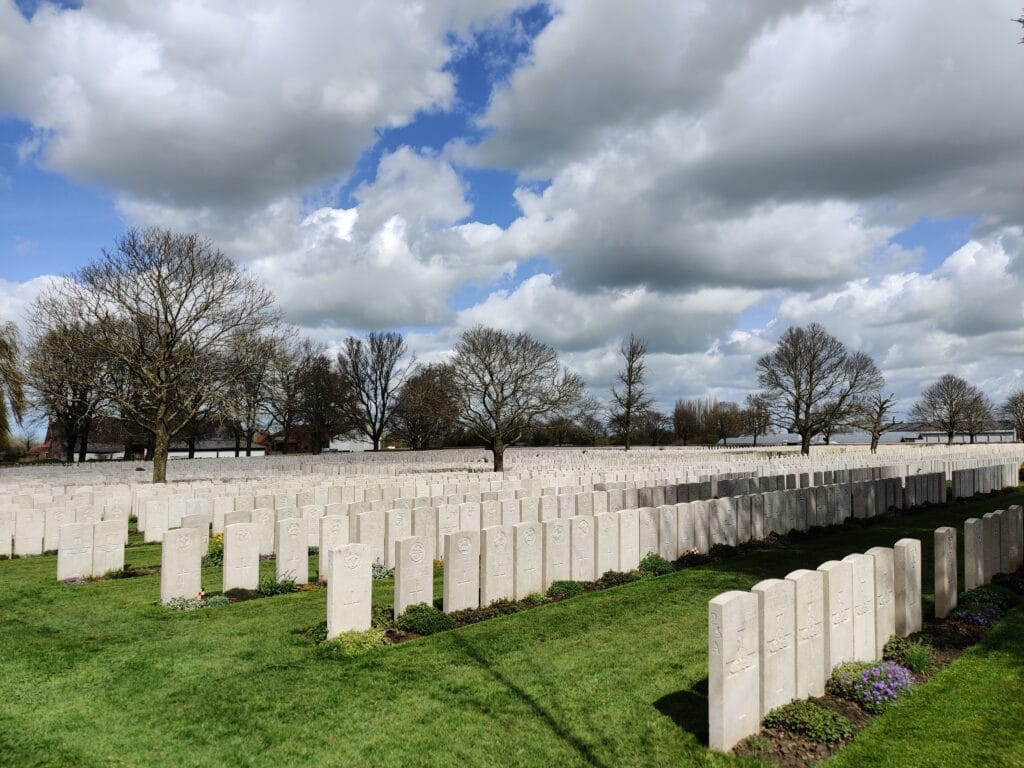
Then, we drove back into Northern France after a very educational and historical trip to Ypres and around Flanders. We arrived earlier than expected, so we visited Auchan to refill on Petrol for the drive back to the UK and hoped to get an earlier train at the EuroTunnel. We were scheduled for an 18:20 train, but got on an hour earlier and annoyingly, the terminal in Calais was shut for shops and food stalls. So we ate dinner in the car park before boarding the train, where I drove up the ramp to the upper deck. The short crossing didn’t take long, and we were driving back towards London after a fantastic trip. It was a holiday my Dad and I had discussed for years, and the reality was a balance of WW1 Historical sites, Cycling and quality father & son time along with some rather strong Belgian beers!
Budget
This 5-day Belgium Trip was neither a complete budget holiday nor a luxury one. The highest costs were the Hotel and the transport, which could have been cheaper using a Ferry or hotels further away. The Novotel was very accommodating, and the Eurotunnel allowed us to maximise the time spent in Belgium. Our main costs per day were Food & Drink, where we took lunch with us in the car most days and found a restaurant for dinner. And when in Belgium, the Beers are a must to sample, with St Arnoldus being my favourite Beer Cafe in Ieper, so budget in some beer money. The total costs below were shared between 2 people, so £500 each for a 5-day and 4-night trip was very good value in my opinion<
| Item | Cost (Pound Sterling) | Cost (Euros) |
| Transport – EuroTunnel | £220 | €262 |
| Accommodation – Hotel | £390 | €465 |
| Petrol | £120 | €143 |
| Food & Drink | £250 | €300 |
| Mueseums | £20 | €24 |
| Sub Total | £1000 | €1464 |
Food & Drink
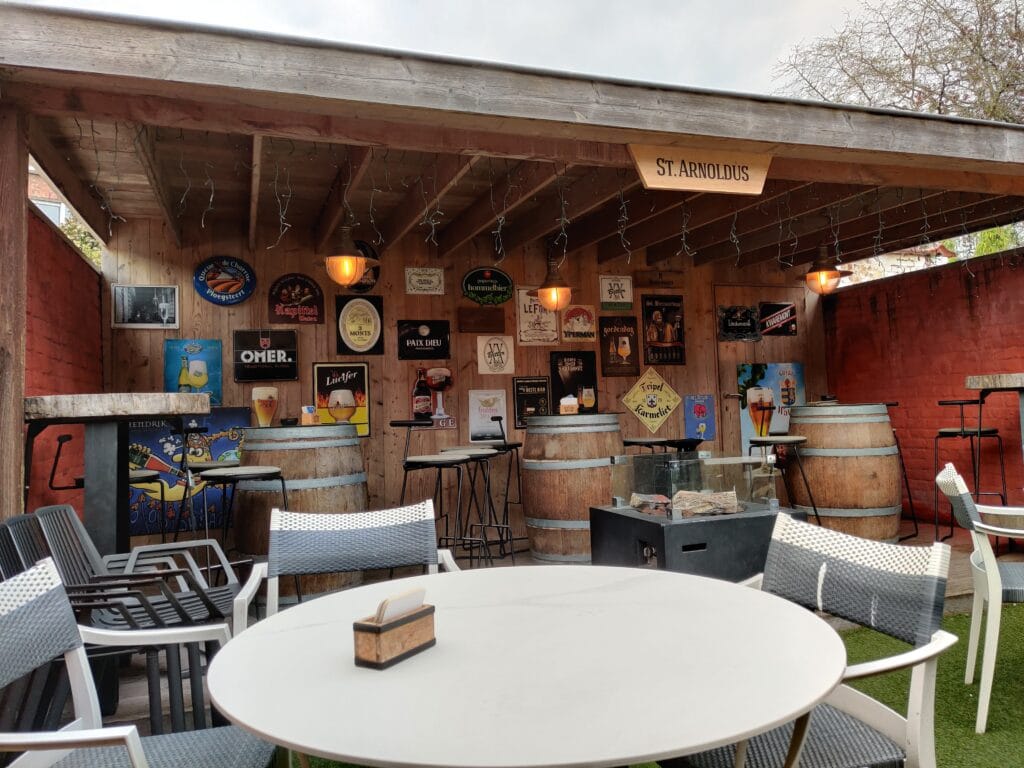
Belgian cuisine is pretty varied and Ypres has plenty of restaurants to wet the appetite. It’s worth trying to book restaurants for popular places, but you’ll be able to find a table even at weekends. My favourite place was St Arnoldus, which has over 25 Belgian Beers on Tap to taste with different styles and strengths! The best restaurant we went to was Marktcafé Les Halles, which we visited twice, it was that good! Other restaurants we tried were Dépot (where you can buy the furniture) and Captain Cook (Italian), and both were very good! In ‘t Klein Stadhuis was always busy for traditional Belgian food but there weren’t as many vegetarian options for me. There is a Carrefour in the centre of town to pick up groceries and a larger Spar-Ieper, a few mins drive outside town.
Tip: Restaurants are busiest around the Last Post Ceremony at Menin Gate, starting at 8pm for 10-15 mins
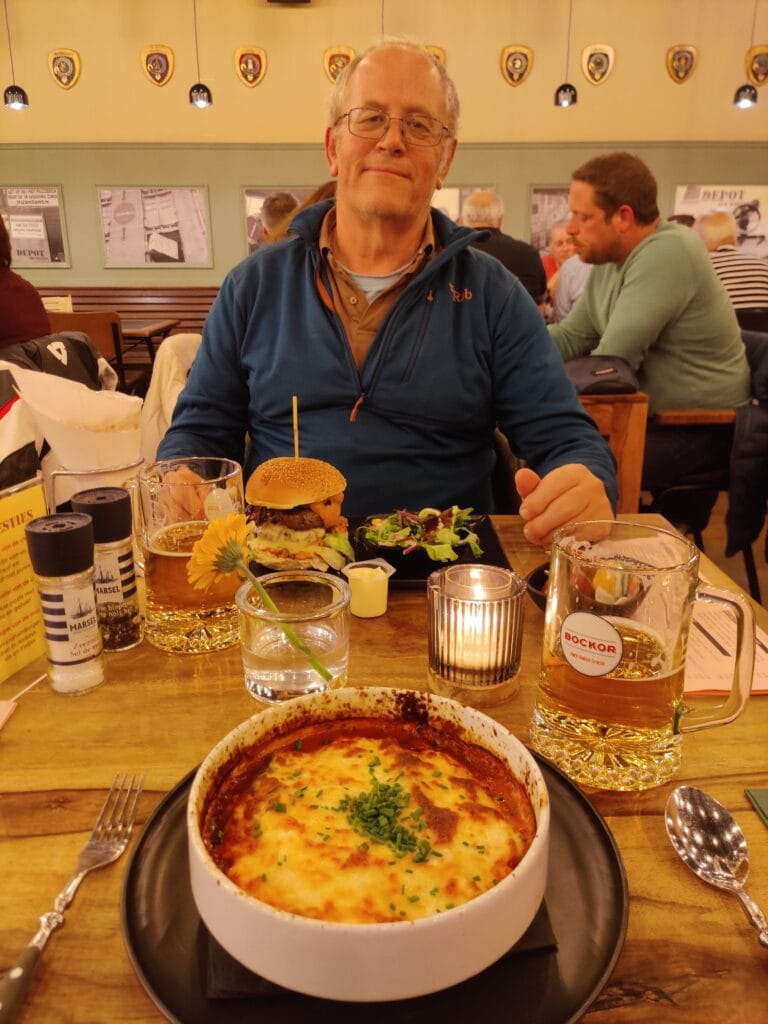
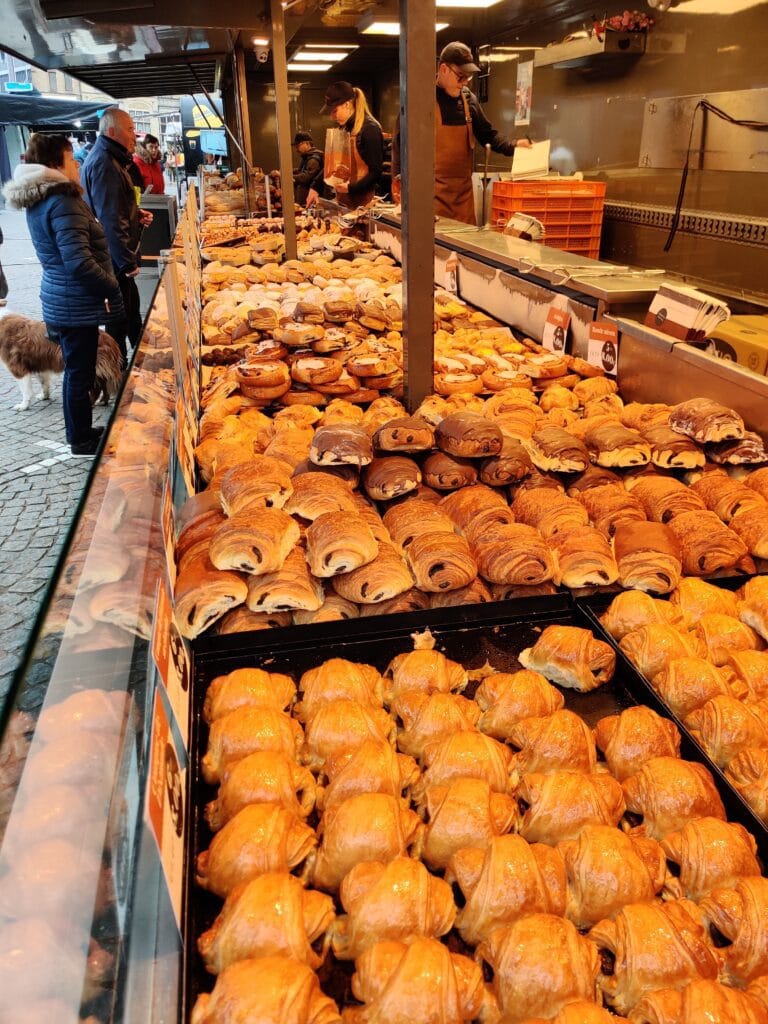
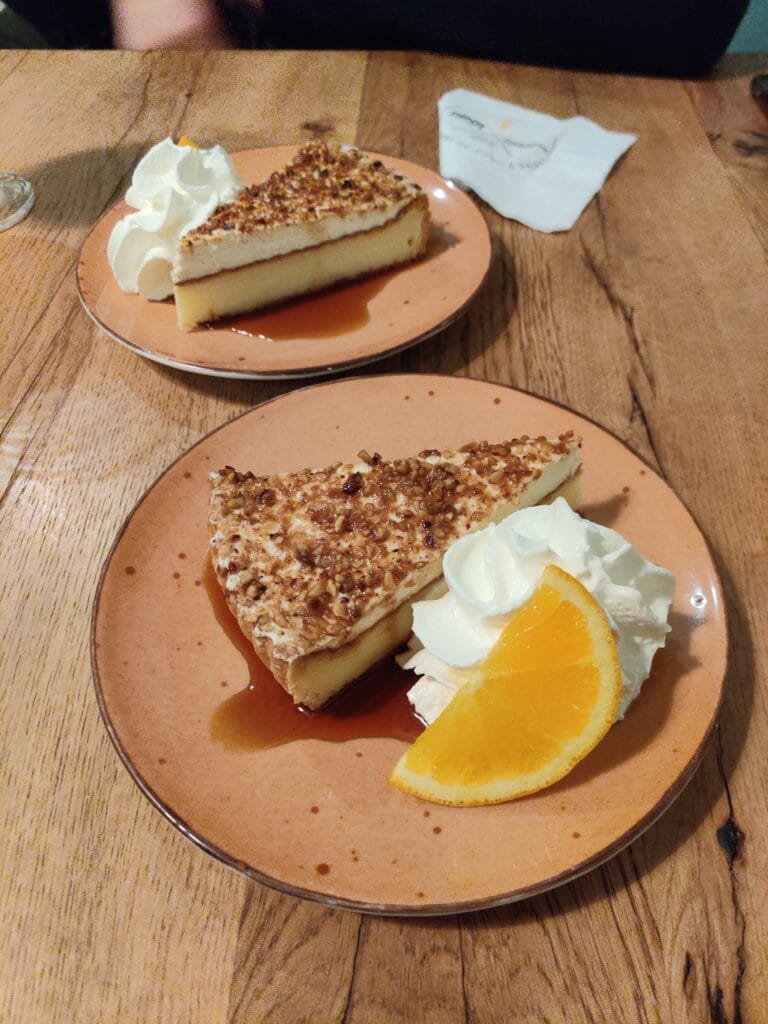
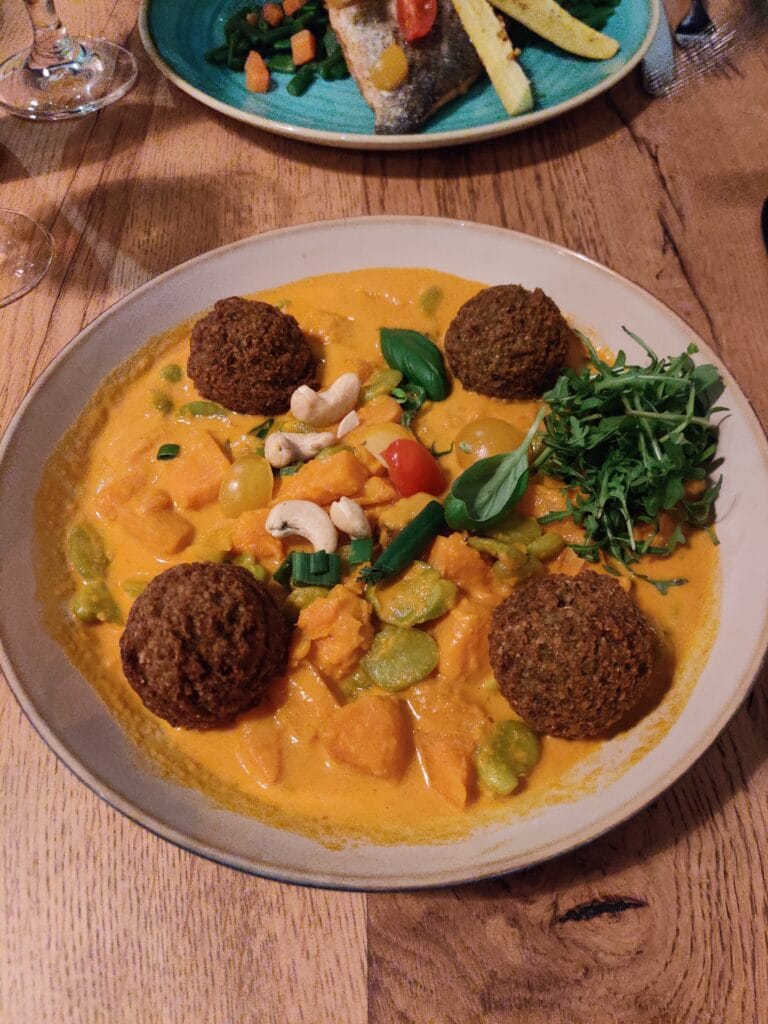
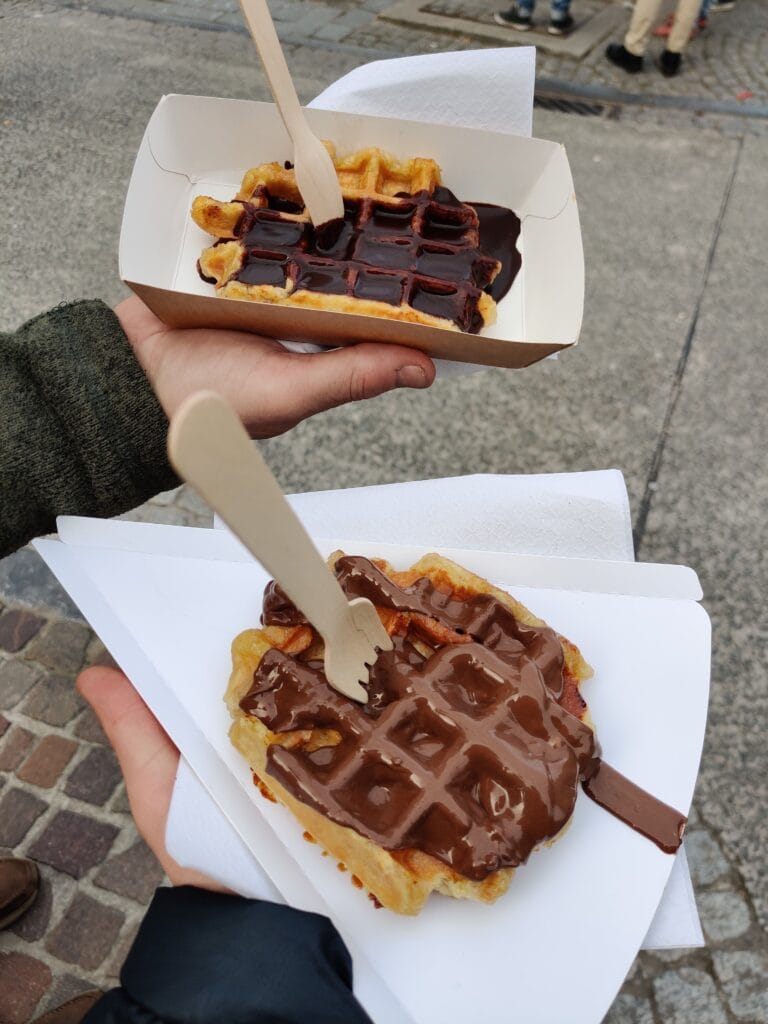
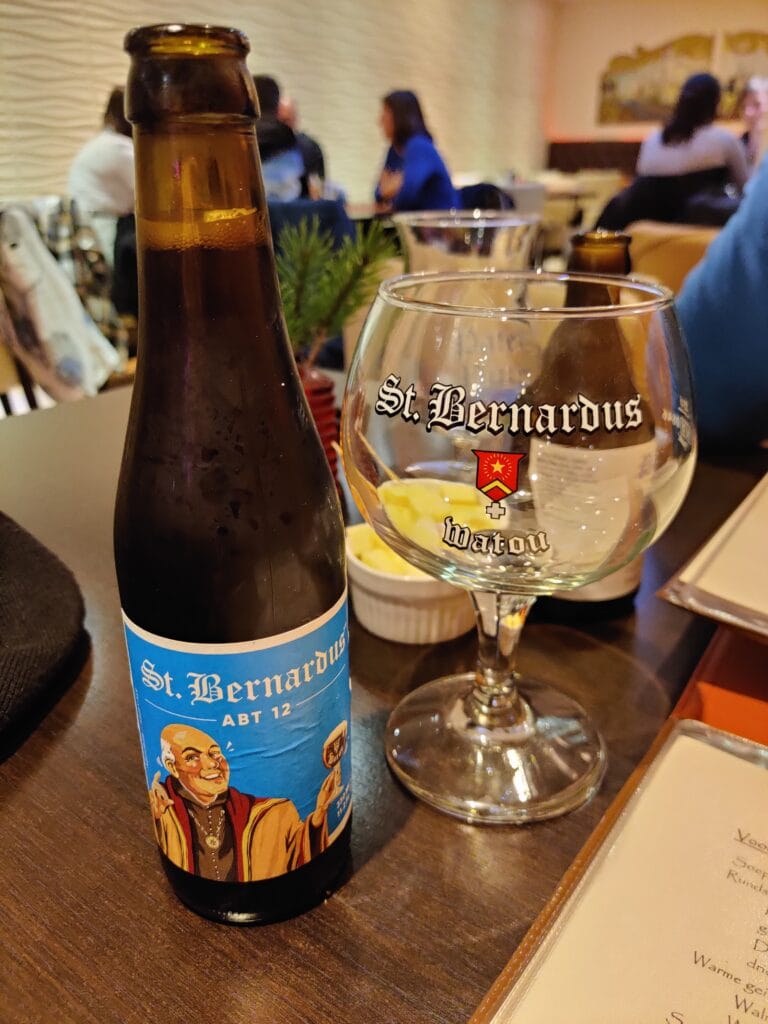
Accommodation
If you are looking to learn about World War 1, then the Ypres Battlefield sites are a must-see. Ypres is a great base camp with many options for accommodation. As well as Airbnb’s, there are over 90 hotels in Ypres to choose from for every budget. We chose Novotel Ieper Centrum Flanders Fields because of its proximity to the centre and affordable prices (see Budget above). The double room had everything we needed for a comfortable night’s sleep and to recharge. It was unfortunate that renovation work to the restaurant was underway which meant no breakfast at the Novotel. There is parking available, but as mentioned, we used free parking over the water. For packing, I used my Hostelling Packing List as I didn’t need to be too minimalist and had a car for extra space.
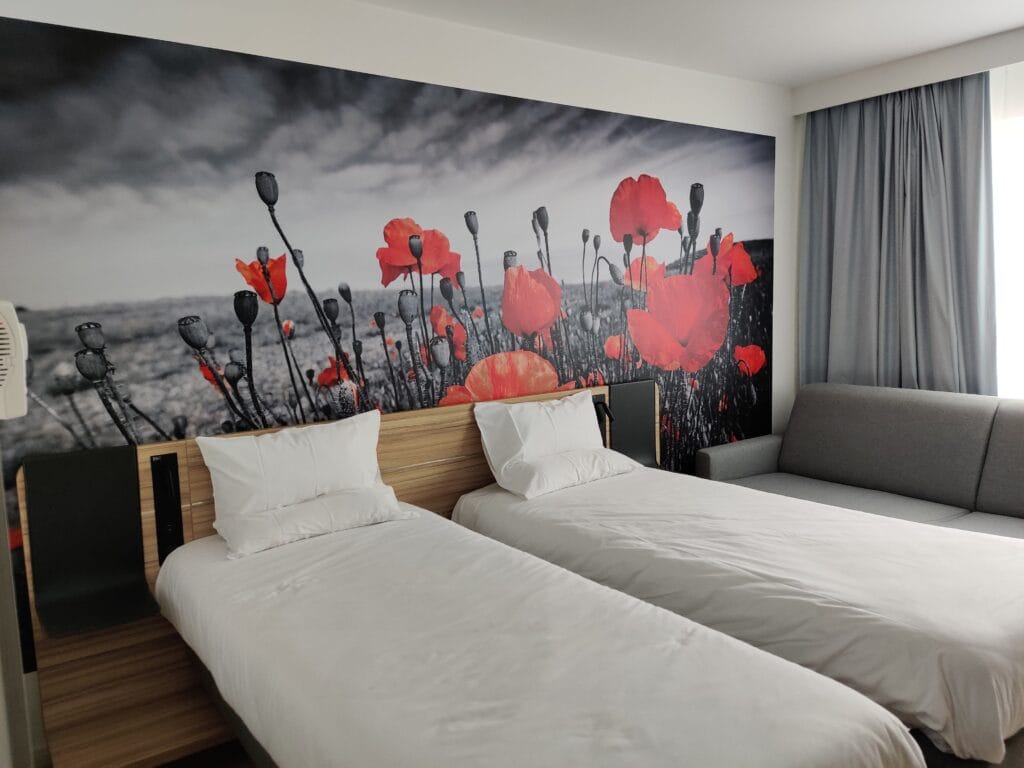
Transport
The easiest way to see all the Ypres Battlefield sites and have the most flexibility is to have a car. Renting a car in Belgium is possible if you’re flying over or use organised Guided Tours to visit all the sites. However, from the UK, using the EuroTunnel is a good way to quickly travel over to Calais and then onto Belgium. Another option is to use a Ferry from Dover to Calais, which is cheaper but longer than the Channel Tunnel
Tip: Use Parkeerplaats in Ypres on the other side of the river from Menenpoort for free 24 hours a day
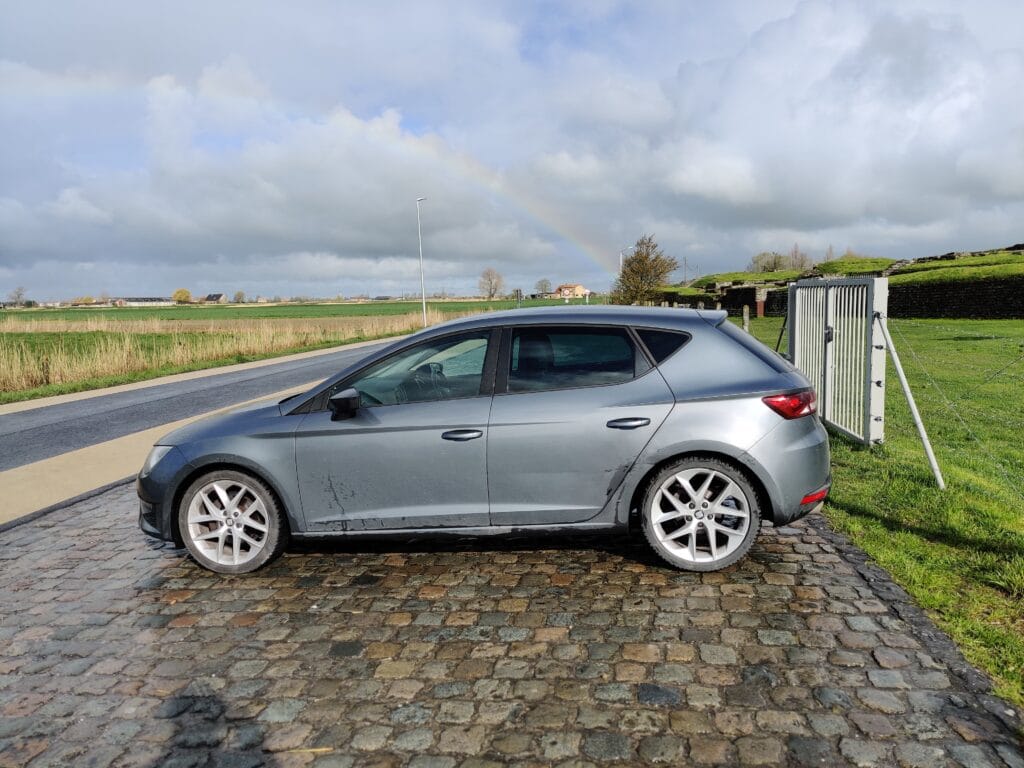
This was my first experience driving abroad on the right-hand side of the road. I was grateful to be in my Seat Leon so that I was familiar with the vehicle and only had to learn about junctions and roundabouts. Ypres is a small city with a good enough road system that was not too difficult to navigate, and the surrounding roads were quiet and well-sized. All of the Ypres battlefield sites and cemeteries had some parking available but varied in size and business. There were many small cemeteries in villages and off roads that can be visited very quickly. I learnt to quickly stop and pull in last minute when my Dad had found another hidden cemetery to visit.
Tip: Make sure you have breakdown cover for Europe driving and put a GB sticker/Magnet on!
Final Thoughts
The Ypres Battlefield sites in Belgium were a trip unlike many others I’ve written about. Instead of hiking up mountains or learning about the culture of cities, it was refreshing to focus on History. The events of World War 1 had long long-lasting impact and to visit the cemeteries, battle sites, and memorials was humbling. The places in this itinerary will make you reflect and pay respects to those who gave the ultimate sacrifice. And Ypres is a wonderful city to stay in and explore in its own right, with the Menin Gate a must-see! I was glad we could weave in my passion for cycling and a shared appreciation of Belgian beer into the trip as well. This trip was focused on the Ypres Salient and not around the Somme region, which is another Historical trip to do.
If you have an interest in World War 1, I would highly recommend visiting Belgium and the Ypres Battlefield sites! Where is your favourite place to visit for historical significance? If you have enjoyed this post or know anyone visiting Ypres, then please share!